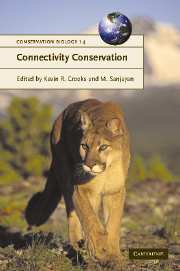Book contents
- Frontmatter
- Contents
- List of contributors
- Acknowledgements
- 1 Connectivity conservation: maintaining connections for nature
- PART I Approaches to connectivity research
- Introduction: Connectivity research—what are the issues?
- 2 Landscape connectivity: a return to the basics
- 3 Connectivity and metapopulation dynamics in highly fragmented landscapes
- 4 Genetics and landscape connectivity
- 5 Connectivity at the land–water interface
- 6 Influence of natural landscape fragmentation and resource availability on distribution and connectivity of gray wolves (Canis lupus) in the archipelago of coastal British Columbia, Canada
- 7 Migratory connectivity
- 8 Connectivity in marine ecosystems: the importance of larval and spore dispersal
- 9 Connectivity and wide-ranging species in the ocean
- 10 Hydrologic connectivity: a neglected dimension of conservation biology
- 11 Connectivity and ecosystem services: crop pollination in agricultural landscapes
- PART II Assessing connectivity
- PART III Challenges and implementation of connectivity conservation
- Index
- References
8 - Connectivity in marine ecosystems: the importance of larval and spore dispersal
Published online by Cambridge University Press: 24 May 2010
- Frontmatter
- Contents
- List of contributors
- Acknowledgements
- 1 Connectivity conservation: maintaining connections for nature
- PART I Approaches to connectivity research
- Introduction: Connectivity research—what are the issues?
- 2 Landscape connectivity: a return to the basics
- 3 Connectivity and metapopulation dynamics in highly fragmented landscapes
- 4 Genetics and landscape connectivity
- 5 Connectivity at the land–water interface
- 6 Influence of natural landscape fragmentation and resource availability on distribution and connectivity of gray wolves (Canis lupus) in the archipelago of coastal British Columbia, Canada
- 7 Migratory connectivity
- 8 Connectivity in marine ecosystems: the importance of larval and spore dispersal
- 9 Connectivity and wide-ranging species in the ocean
- 10 Hydrologic connectivity: a neglected dimension of conservation biology
- 11 Connectivity and ecosystem services: crop pollination in agricultural landscapes
- PART II Assessing connectivity
- PART III Challenges and implementation of connectivity conservation
- Index
- References
Summary
INTRODUCTION
Connectivity is a concept shared in landscape and metapopulation ecology that is used to describe the movement or exchange of organisms between habitats on various temporal and spatial scales (Gilpin and Hanski 1991; Hanksi and Gilpin 1997; Crooks and Sanjayan Chapter 1; Taylor et al. Chapter 2; Moilanen and Hanski Chapter 3) and its population and community consequences. Many marine habitats, such as kelp forests, estuaries, wetlands, seagrass beds, coral and rocky reefs, and deep-sea hydrothermal vents, are naturally fragmented and patchy. As a result, many scientists working with marine populations and associated systems adopt a metapopulation-based interpretation of connectivity where landscapes are viewed as a network of habitat patches or fragments in which species occur as discrete local populations connected by the passive and active migration of individuals. In marine systems, connectivity may be generated by movements of early life stages such as larvae or spores (hereafter referred to as propagules), juveniles, or adults.
The majority of marine organisms, including benthic (living on or in the bottom), demersal (living near and in close association with the bottom), and holoplanktonic (living in the plankton) species, have a complex life cycle characterized by planktonic stages of development (e.g., larvae, spores). In the case of marine invertebrates and fishes, propagules exhibit a diversity of nutritional modes, development sites, planktonic durations, and morphological development patterns that can affect patterns of connectivity (Table 8.1).
- Type
- Chapter
- Information
- Connectivity Conservation , pp. 184 - 212Publisher: Cambridge University PressPrint publication year: 2006
References
- 9
- Cited by



